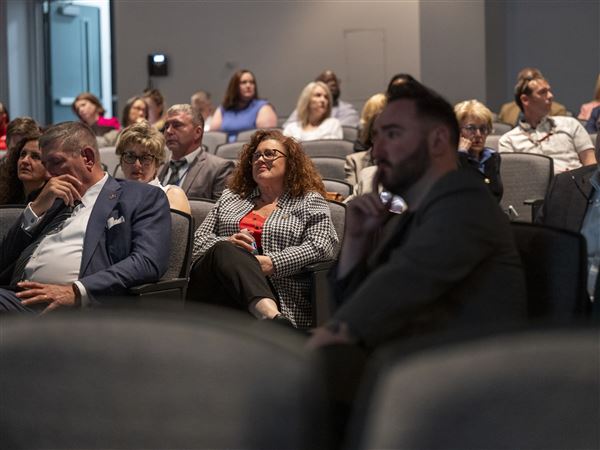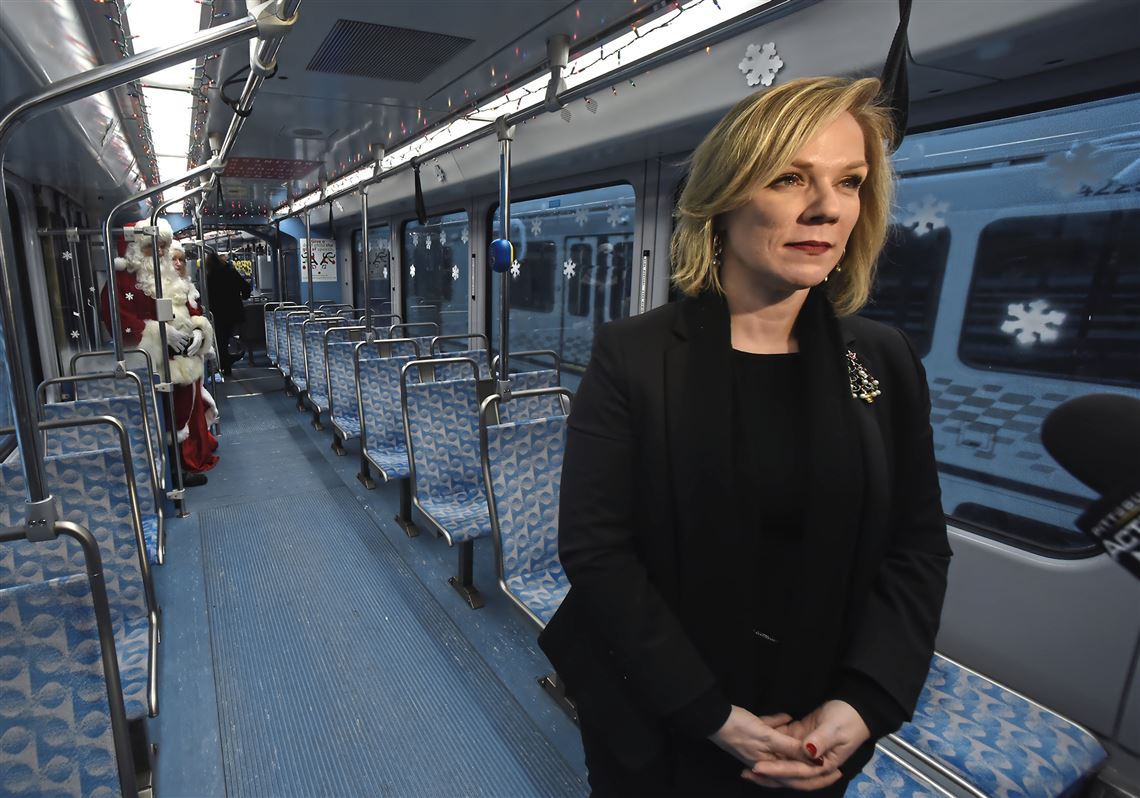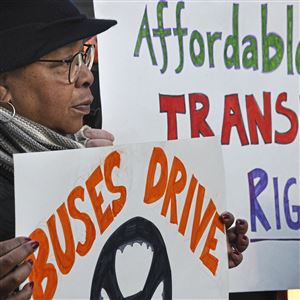It was a busy first year for Katharine Eagan Kelleman as CEO at the Port Authority.
In 12 months, Ms. Kelleman navigated her way through issues that began before her hire such as whether to begin cashless fares on the T (no), use armed officers for fare enforcement (no) and cut suburban service and force transfers in Oakland on the proposed Bus Rapid Transit system (no and no).
Along the way, she dealt with flooding in the South Hills and a Norfolk Southern train derailment that caused problems for the agency’s light-rail service. She also has revamped the agency’s top staff and started new processes such as long-term planning, branding the agency and improving on-time service.
But mostly, she's become the public face of an agency that didn't have one.
Ms. Kelleman started the first week of January, arriving here after nearly four years heading the Hillsborough Area Regional Transit Authority in Tampa, Fla. She brought a strong transportation planning background to an agency that had spent the previous three years stabilizing its finances after years of service reductions due to cuts in state funding.
“I would not be here if it wasn’t for the good financial work done before me,” Ms. Kelleman said, praising her predecessor, Ellen McLean. “It was a very clean slate to come into. I’m very happy to be here, where what I’m good at [service planning] is what we need.”
Within weeks, she was a common sight whether in public riding the T to work most days from the South Hills or donning hard-toe shoes to visit authority garages and light-rail maintenance facilities to familiarize herself with the system and spread her message that the transit system’s goal is to be great.
At the beginning of March, the agency passed out 3,000 flashlights to workers on national Employee Appreciation Day to encourage them to show the way to improvements. About 60 employees volunteered to march with the agency’s first-in-recent-memory St. Patrick’s Day-themed bus.
“From my second day here, [employees] were delighted to hear someone say we could be excellent, we could do well,” Ms. Kelleman said. “I was surprised how quickly they came on board with the idea we can do more and do better.”
Authority spokesman Adam Brandolph said the new CEO’s positive attitude is contagious.
“Katharine brought an energy,” he said. “It’s lead by example. She’s excited to be here and that’s obvious.”
Here’s an example of how that change has carried over to some employees: In years past, the agency might have one or two buses or light-rail vehicles voluntarily decorated by drivers and their co-workers for the holidays, but there are more than a dozen this year. The agency regularly gets positive comments from riders for the decorated vehicles.
“We didn’t bring the esprit de corps, but we allowed it to come out,” said Ms. Kelleman, who regularly takes her young sons with her to visit garages on holidays to show the agency’s appreciation of their efforts. Her “C Suite,” her eight top managers, all have hard-toe shoes to join her in site visits throughout the year.
She’s revamped that top management staff in from five to eight members and added diversity, changing from five members that had one minority and no women to eight members with three minorities and two women. Overall, Ms. Kelleman’s first budget added $3.7 million for 40 new positions, including 15 administrators.
The three new administrative positions: Chief Development Officer David Huffaker, who’s in charge of long-range planning; Chief Information Officer Jeffrey Devlin, who oversees computer operations, including fare payment systems and development of a mobile payment app; and Chief of Staff Vasti Amaro, who has extensive experience in transit operations and started as a consultant last spring
In addition, long-time Chief of Operations Bill Miller retired this month and will be replaced in early 2019.
“Now, all the staff has someone they can look at and say, ‘I can be like them,’” Ms. Kelleman said. “We’re in really good shape to move forward” on the authority board’s goal of providing riders with a positive transit experience.
Externally, the challenges were larger, described during her interview process as “thorny” issues.
A coalition of public-interest groups were fighting plans in the Monongahela Valley for service cuts and mandatory transfers in Oakland as part of the Bus Rapid Transit system planned between Downtown and Oakland. Similarly, plans for the authority to go to a cashless light-rail system and have fare payment enforced by armed police officers weren’t well received in many quarters.
One of Ms. Kelleman’s first orders was for staff to rethink the service cuts and transfers, which would have hit some of Allegheny County’s poorest communities. Advocates complained bitterly that the authority developed its plans without community input and flooded community meetings in protest.
When the agency began a second round of meetings at the Rankin Christian Center in April, that changed. Ms. Kelleman and her staff started the meeting by announcing transfers would be eliminated and the neighborhoods would continue to have direct service to Downtown Pittsburgh, utilizing the exclusive lanes of the new system.
To Ms. Kelleman, that was a key moment.
“People were saying, ‘We can see you listened,’ ” she said. “Clearly if we wanted to move forward as partners with our community, we had to gain their trust.”
That doesn’t mean the new administration has won over everyone.
Jonah McAllister-Erickson, chairman of the steering committee for Pittsburghers for Public Transit, praised Ms. Kelleman for being more accessible.
“I would say on the whole we’re fairly happy,” he said. “They’ve been much more responsive to some concerns.”
But Dan Yablonsky, the group’s spokesman, called the authority “a big ship to turn” and said it can do a better job involving the public in decisions rather than reacting later. For example, the group was rebuffed in its attempt to be involved in developing specifications for the proposed mobile app and the screening process for selecting a supplier.
““They’re going in the right direction, but there’s still a way to go,” he said.
Steve Palonis, business agent for the Amalgamated Transit Union that represents operators and maintenance personnel, acknowledged the positive image change under Ms. Kelleman. But he said the agency has made so many changes, including an incoming director of operations who deals most directly with his members, that it’s “too soon” to evaluate her.
“She’s made a lot of changes. The jury’s still out,” he said.
For the new year, Ms. Kelleman has more irons in the fire.
In addition to developing the mobile app, the agency is in the process of hiring a fare consultant to help with equity issues such as the cost of transfers and access to prepaid ConnectCards; moving toward her goal of improving on-time performance from 67 to 73 percent by adjusting schedules and making sure vehicles are ready for drivers to begin their shifts; continuing to refine Bus Rapid Transit plans and perhaps beginning street reconstruction on Forbes and Fifth avenues in Uptown; working with consultants to create a new brand for the agency; and looking at less expensive street-level alternatives to the proposed $550 million extension of the Martin Luther King Jr. East Busway from Rankin to Turtle Creek.
Overall, she said she’s satisfied with her first year and happy she came to Pittsburgh.
“We got back to our roots. We went back to our community and got them involved,” she said. “Coming to Pittsburgh is the second best decision I’ve ever made. The first was letting my [then-future] husband buy me a drink.”
Ed Blazina: eblazina@post-gazette.com, 412-263-1470 or on Twitter @EdBlazina.
First Published: December 30, 2018, 4:23 a.m.


















